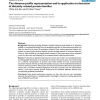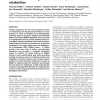62 search results - page 2 / 13 » Evolutionary Networks in the Formatted Protein Sequence Spac... |
BMCBI
2006
13 years 5 months ago
2006
Background: Since the publication of the first draft of the human genome in 2000, bioinformatic data have been accumulating at an overwhelming pace. Currently, more than 3 million...
BMCBI
2005
13 years 4 months ago
2005
Background: Detecting homology between remotely related protein families is an important problem in computational biology since the biological properties of uncharacterized protei...
IJCNN
2006
IEEE
13 years 11 months ago
2006
IEEE
— The ability to identify protein binding sites and to detect specific amino acid residues that contribute to the specificity and affinity of protein interactions has importan...
NAR
2008
13 years 5 months ago
2008
Protein sequences are the most important source of evolutionary and functional information for new proteins. In order to facilitate the computationally intensive tasks of sequence...
RECOMB
2004
Springer
14 years 5 months ago
2004
Springer
In nature, one finds large collections of different protein sequences exhibiting roughly the same three-dimensional structure, and this observation underpins the study of structur...


